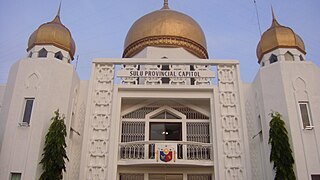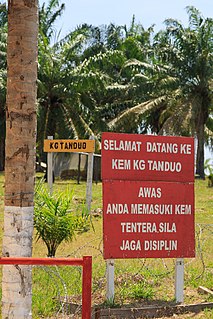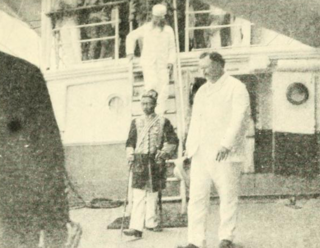
Sulu is a province of the Philippines in the Sulu Archipelago and part of the Bangsamoro Autonomous Region in Muslim Mindanao (BARMM).

The Sultanate of Sulu was a Muslim state that ruled the islands in the Sulu Archipelago, parts of Mindanao, certain portions of Palawan and north-eastern Borneo.

The Tausūg or Suluk people are an ethnic group of the Philippines, Malaysia and Indonesia. The Tausūg are part of the wider political identity of Muslims of Mindanao, Sulu and Palawan. Most of the Tausugs have converted into the religion of Islam whose members are now more known as the Moro group, who constitute the third largest ethnic group of Mindanao, Sulu and Palawan. The Muslim Tausugs originally had an independent state known as the Sulu Sultanate, which once exercised sovereignty over the present day provinces of Basilan, Palawan, Sulu, Tawi-Tawi, the eastern part of the Malaysian state of Sabah and North Kalimantan in Indonesia.

The North Borneo dispute is the territorial dispute between the Federation of Malaysia and the Republic of the Philippines over much of the eastern part of the state of Sabah, a territory known as North Borneo prior to the formation of the Malaysian federation. The Philippines, presenting itself as the successor state of the Sultanate of Sulu, retains a "dormant claim" on Sabah on the basis that the territory was only leased to the British North Borneo Company in 1878, with the sovereignty of the Sultanate over the territory never having been relinquished. However, Malaysia considers this dispute as a "non-issue" as it interprets the 1878 agreement as that of cession and that it deems that the residents of Sabah had exercised their right to self-determination when they joined to form the Malaysian federation in 1963.
Jamalul ibni Punjungan Kiram III was a former self-proclaimed Sultan of the Sulu Sultanate who claimed to be "the poorest sultan in the world". He was known as an unsuccessful candidate for senator in the past Philippine general elections in 2007. In 2013, Kiram III sparked a controversy when he revived a dispute between the Philippines and Malaysia by leading an intrusion into the eastern part of Sabah. His daughter is Princess Jacel Kiram, a proponent of the Sabah claim of the Philippines in 2016.
Sultan Muwallil Wasit, is the 9th Sultan of Sulu and was also known as Rajah Bongsu I. His birth name was Pangiran Shahbandar Maharajalela, and was the youngest son of former Sultan of Brunei Muhammad Hassan. He reigned in Sulu after his uncle, Sultan Batara Shah Tengah died without an heir. He was most likely sent to Sulu to end dynastic troubles there, as he was begot of the marriage of Batara Tengah's Sister, and the Sultan of Brunei. On his coming to Sulu in 1609, this Pangiran Shahbandar Maharajalela @ Raja Bongsu-I ibni Sultan Muhammad Hassan brought along his royal symbol's called as "Pulau Janggi" and "Sepong Janggi". This royal symbol was a symbol of brotherhood between Sulu Sultanate and Brunei sultanate. And as a royal proof to Raja Bongsu-I as he was really belongs to Brunei Sultanate royal family. So, at present to identify the true Sulu Sultanate heir's is by identify who is the sulu royal family mandated to {Holding} this royal symbol. And the person who can proceed to have a photo's while holding this royal symbol, that person indeed is the true Sulu Sultanate heir AND also the true Successor to the Sulu Sultanate kingdom.

Muedzul Lail Tan Kiram is the head of the Royal House of Sulu, a position which he has held since 16 February 1986. As the eldest son of the former Sultan Mohammed Mahakuttah Abdullah Kiram, he is the legitimate heir claimant to the throne of the Sultanate of Sulu. He is a pretender to the throne as the 35th Sultan of Sulu.
The Royal House of Sulu is an Islamic royal house which ruled the Sulu Sultanate. In 1962, the Philippine Government under the leadership of President Diosdado Macapagal officially recognized the continued existence of the Royal Sultanate of Sulu. On May 20, 1974 Sultan Mohammad Mahakuttah Kiram was recognized under Memorandum Order 427, issued by then President Ferdinand Marcos again confirming the existence of the Sultanate of Sulu. Memorandum Order No. 427 states that "The Government has always recognized the Sultanate of Sulu as the legitimate claimant to the historical territories of the Republic of Philippines". The memorandum states that Sultan Mohammed Mahakuttah Abdullah Kiram is officially the recognized Sultan of Sulu. Sultan Mahakuttah A. Kiram's eldest son Muedzul Lail Tan Kiram was finally recognized as the 35th Legitimate Sultan of Sulu in the year 2012 by the people of Sulu. As the eldest son of the former Sultan, he is the legitimate heir to the throne of the Sultanate of Sulu. The current ruling lineage is the Royal House of Kiram. The Royal House of Kiram descends from Sultan Jamalul Kiram I, who was the Sultan of Sulu from 1823–1844.
Ismael ibni Punjungan Kiram II was a self-proclaimed Sultan of the Sultanate of Sulu from 12 March 2001 until his death.

The 2013 Lahad Datu standoff was a military conflict that started on 11 February 2013 and fully ended on 24 March 2013. The conflict began when 235 militants, some of whom were armed, arrived by boats in Lahad Datu District, Sabah, Malaysia from Simunul island, Tawi-Tawi, in the southern Philippines. The group, calling themselves the "Royal Security Forces of the Sultanate of Sulu and North Borneo", was sent by Jamalul Kiram III, one of the claimants to the throne of the Sultanate of Sulu.

A Bangsamoro state has been declared from the Republic of the Philippines three times. A state was first declared in 1974. In 2012, Bangsamoro Land was declared. A year after, the United Federated States of Bangsamoro Republik was declared.
The Spanish occupation of Jolo or Battle of Jolo was a military expedition in the 1630s to pacify the Moro of the Sulu Sultanate. The expedition, personally led by Sebastian de Corcuera, the then Governor-General of the Spanish East Indies was a follow-up expedition to the earlier successful campaigns against the Maguindanao Sultanate under Sultan Qudarat. It was initially successful, partly due to an epidemic within the Sultan Wasit's fort early in the campaign, resulting in the Sulu forces retreating to Tawi-Tawi.
Sultan Batara Shah Tengah was the 8th Sultan of Sulu. He reigned from 1596 to 1608. He was the son of the previous Sultan Muhammad ul-Halim, also known as Pangiran Buddiman.

Sultan Mohammed Mahakuttah A. Kiram was the 34th Sultan of Sulu (1974–1986). He was the eldest son of Sultan Mohammed Esmail Kiram I and the heir apparent to the throne. He was the last Sultan of Sulu officially recognised by the Philippine government.
Sultan Mohammed Esmail Kiram was a Sultan of Sulu. He ruled from 1950 to 1974.

Jamalul Kiram II was Sultan of Sulu and North Borneo (1894–1936). During his long reign, he signed several treaties with different nations.

The Lahad Datu District is an administrative district in the Malaysian state of Sabah, part of the Tawau Division which includes the districts of Kunak, Lahad Datu, Semporna and Tawau. The capital of the district is in Lahad Datu Town.
Jamalul Kiram may refer to:













